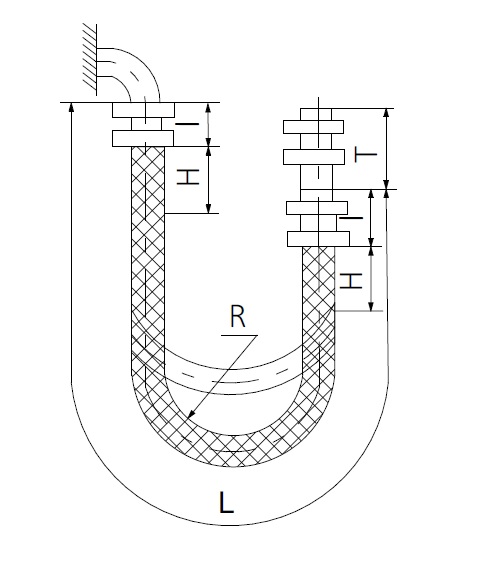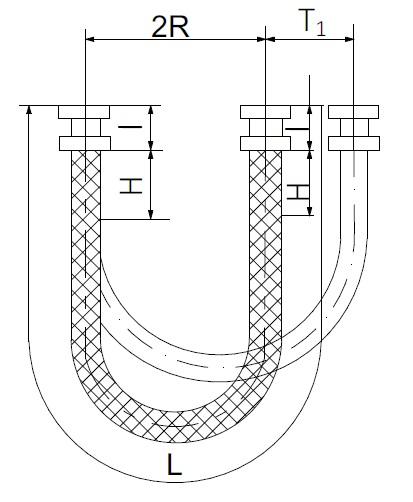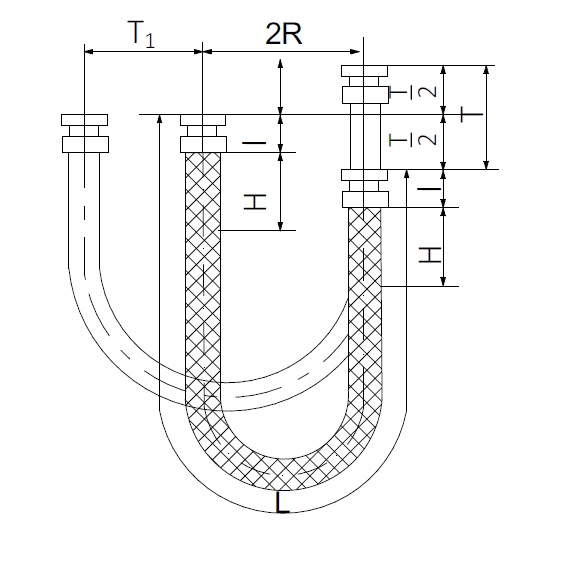Recommendations on UZM's metal RGM hoses selections
Selection guideline
When choosing a metal hose one should be guided by the conditions in which the operation of the product is expected. To simplify this process, the selection of metal hose can be divided into four stages: inner diameter, operating pressure, product length, type of connection.
Example of RGM metal hose marking:
RGM 50-40-1, 0 c/a
Decryption:
RGM – product’s series (pressure-tight metal hoses);
50-nominal inner hose diameter, mm;
40 - the highest working pressure of a hose in kgf / cm2 (ATM) under normal operating conditions;
1.0-nominal length of a hose assembly, m;
c / a – availability of special end fittings in accordance with Customer requirements. A full description of the end fittings is presented in the Customer's passport. Hoses without c/a marked abbreviation – are hoses without fittings with ends for welding
Conventional inner diameter of the metal hose is the nominal parameter used in the description of pipeline systems, as a characteristic feature in the installation and fitting to each other parts of the pipeline. The nominal inner diameter is calculated in the design in such a way as to provide the required capacity of the metal hose.
The selection of the nominal inner diameter of the metal hose is determined by the following formula:

where Dy- nominal inner diameter of the metal hose, mm;
Q - flow rate of the operating medium passing through the hose, l / min;
V – the average speed of the operating medium, m / s.
In calculating it is necessary to remember that the rupture of the inner surface of the corrugation occurs while pumping the operating medium through the metal hose; leading to pulsating load and vibration of the corrugations. Based on the above, it is not allowed to use the metal hose at speeds of flow rate more than 8 m/s for liquids and 50 m/s for gases.
The operating pressure is the highest value of the pressure of the transported medium at which the specified operating mode is provided.
Depending on the operating conditions, the maximum operating pressure during operation is defined as the derivative of the nominal pressure Py defined by the temperature coefficient and the dynamic load coefficient:
Р = Pу · Kd· Кt, where
Kd– is the coefficient of dynamic loads in accordance with table 1;
Kt-is the temperature coefficient in accordance with to table 2.
Dynamic load coefficient, Kd
|
Flow condition |
No vibration, weak slow movements |
Vibration, frequent steady movements |
Strong vibration, rhythmic pulsating movements |
|
Vibrational load |
|||
|
Static or slow smooth flow |
1,00 |
0,90 |
0,50 |
|
Unsteady pulsating flow |
0,90 |
0,75 |
0,40 |
|
Rhythmic pulsating flow |
0,40 |
0,30 |
0,20 |
The highest operating pressure P(operating) of the hose assembly at any temperature must be the lowest of the permissible pressures for any part of the hose at 20°C, multiplied by the corresponding Kt reduction coefficient.
Тable 2
Temperature coefficient, Kt
|
Temperature in°C, up to |
20 |
50 |
100 |
150 |
200 |
250 |
300 |
350 |
400 |
|
Temperature coefficient, Kt |
1,00 |
0,92 |
0,83 |
0,75 |
0,68 |
0,59 |
0,59 |
0,56 |
0,54 |
Nominal length- is determined by the Customer, based on the requirements for the hoses installation.
When choosing a metal hose, it is necessary to determine its optimal length for a particular installation case, since the usage of the hose that is too short or too long can lead to product’s damage at the place of fitting connection. The neutral areas near the fittings, that are not subject of bending during operation, must be taken into account as well in choosing the length of a metal hoses.
Calculation of the minimum length during movements:
Vertical displacement with large amplitude (T) 
L=2H+T+3.14 R+2La where:
L -is the length of the metal hose
H- is the length of the neutral space
T -is the distance of movement
R- is the bend radius
La- is the length of fitting
|
Diameter ,DN (nominal), mm |
The minimum length of the neutral space |
|
6 - 16 |
5 |
|
20 - 50 |
4 |
|
65 - 100 |
3 |
|
125 - 150 |
2,5 |
|
200 - 250 |
2 |
Horizontal movement with large amplitude (T1)
L=2H+1,57 Т1+3,14R+2La
Moving in two directions with large amplitude (T and T1)
L=2H+1,5T1+T/2+3,14R+2La
It is possible to manufacture long hose assemblies by joining several hose parts, upon Customer’s request. Connection is carried out by welding with fittings for welding.
End fitting is the end of the metal hose serving to attach it to the parts embedded in the pipeline system.
Customer based on requirements of metal hose selecting the type of the end fittings. The most common type of end fittings is the end for welding. Also the most often used ones are threaded connections (union nuts, nipples, etc.), flange connections, quick couplings and others. See more on the end fittings page.
In addition to the type of end fittings, there is another parameter that affects both the cost and the operation of the metal hose. This is the material from which the end fittings are made. The most common materials are stainless steel and carbon steel.
End fittings of RGM (pressure-tight metal hoses) series can be made in accordance with standards (GOST, DIN, ANSI) or according to Customer’s drawings. Our own lathe machines park allows executing fittings of any complexity, on condition of providing a full package of technical documentation.
 Рус
Рус Eng
Eng Қаз
Қаз Блр
Блр